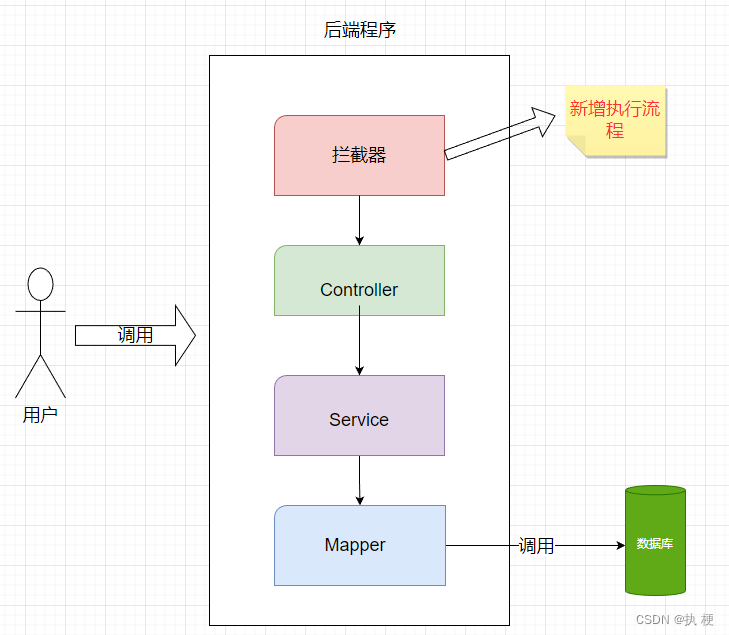【Spring从入门到实战】第 5 讲:SpringBoot实现拦截器及其原理
创始人
2025-05-28 21:29:12
0次
专栏前言
大家好,我是执梗。本专栏将从Spring入门开始讲起,详细讲解各类配置的使用以及原因,到使用SpringBoot进行开发实战,旨在记录学习生活的同时也希望能帮到大家,如果对您能有所帮助,还望能点赞关注该专栏,对于专栏内容有错还望您可以及时指点,非常感谢大家 🌹。
目录
- 专栏前言
- 1.什么是拦截器?
- 2.拦截器的实现
- 3.拦截器的实现原理
- 4.拦截器的拓展
1.什么是拦截器?
在本专栏上文中,我们讲解了AOP,在用户验证登陆功能上,可以利用它来进行统一,但使用它却有两个很大的缺点:
- 1.无法获取到
HttpSession对象 - 2.我们要实现对一部分方法拦截,一部分方法放行,这是很困难的,甚至无法完成。比如用户验证登陆中登陆和注册方法肯定是需要放行的。
为了解决上述问题,Spring中为我们准备了拦截器:HandlerInterceptor。
2.拦截器的实现
拦截器的实现,主要分成两个步骤:
- 1.创建一个自定义拦截器,实现接口
HandlerInterceptor并重写方法preHandle,这个方法会在执行所有方法之前预先执行。
代码实现:
import org.springframework.stereotype.Component;
import org.springframework.web.servlet.HandlerInterceptor;import javax.servlet.http.HttpServletRequest;
import javax.servlet.http.HttpServletResponse;
import javax.servlet.http.HttpSession;/** 自定义重写拦截器* */
@Component
public class LoginIntercept implements HandlerInterceptor {@Overridepublic boolean preHandle(HttpServletRequest request, HttpServletResponse response, Object handler) throws Exception {//1.得到session对象HttpSession session = request.getSession(false);if (session != null && session.getAttribute("userinfo") != null) {//说明已经登陆,可以放行return true;}// 执行到这行表示未登录,未登录就重定向到到登陆页面response.sendRedirect("/user/login");return false;}
}
- 2.将自定义拦截器加入到
WebMvcConfigurer的addInterceptors方法中。
代码实现:
import org.springframework.beans.factory.annotation.Autowired;
import org.springframework.context.annotation.Configuration;
import org.springframework.web.servlet.config.annotation.InterceptorRegistry;
import org.springframework.web.servlet.config.annotation.WebMvcConfigurer;@Configuration
public class AppConfig implements WebMvcConfigurer {@Autowiredprivate LoginIntercept loginIntercept;@Overridepublic void addInterceptors(InterceptorRegistry registry) {registry.addInterceptor(loginIntercept).addPathPatterns("/**").excludePathPatterns("/user/login").excludePathPatterns("/user/reg").excludePathPatterns("/login.html").excludePathPatterns("/reg.html").excludePathPatterns("/**/*.css").excludePathPatterns("/**/*.jpg");}
}
其中函数的作用:
addPathPatterns:表示需要拦截的 URL,**的意思表示所有方法,在这表示拦截所有的方法excludePathPatterns:表示排除的 URL,也就是需要放行的方法。通常我们应该将登陆和注册功能放行以及各种静态资源(图片、JS 和 CSS 文件)。
3.拦截器的实现原理
经过拦截器的加入后,我们程序的执行流程将会是下图这样:

从源码来看,所有的Controller执行时,都会通过一个调度器DispatcherServlet来进行实现,我们可以从SpringBoot的打印日志看出这一点:

所有方法都会被其中的doDispatch进行调度,进入源码观察,在我注释的地方,它先执行applyPreHandle预处理方法,才会进入Controller层。
protected void doDispatch(HttpServletRequest request, HttpServletResponse response) throws Exception {HttpServletRequest processedRequest = request;HandlerExecutionChain mappedHandler = null;boolean multipartRequestParsed = false;WebAsyncManager asyncManager = WebAsyncUtils.getAsyncManager(request);try {try {ModelAndView mv = null;Exception dispatchException = null;try {processedRequest = this.checkMultipart(request);multipartRequestParsed = processedRequest != request;mappedHandler = this.getHandler(processedRequest);if (mappedHandler == null) {this.noHandlerFound(processedRequest, response);return;}HandlerAdapter ha = this.getHandlerAdapter(mappedHandler.getHandler());String method = request.getMethod();boolean isGet = HttpMethod.GET.matches(method);if (isGet || HttpMethod.HEAD.matches(method)) {long lastModified = ha.getLastModified(request, mappedHandler.getHandler());if ((new ServletWebRequest(request, response)).checkNotModified(lastModified) && isGet) {return;}}// 进行预处理,也就是进入拦截器if (!mappedHandler.applyPreHandle(processedRequest, response)) {return;}//执行Controller层的业务方法mv = ha.handle(processedRequest, response, mappedHandler.getHandler());if (asyncManager.isConcurrentHandlingStarted()) {return;}this.applyDefaultViewName(processedRequest, mv);mappedHandler.applyPostHandle(processedRequest, response, mv);} catch (Exception var20) {dispatchException = var20;} catch (Throwable var21) {dispatchException = new NestedServletException("Handler dispatch failed", var21);}this.processDispatchResult(processedRequest, response, mappedHandler, mv, (Exception)dispatchException);} catch (Exception var22) {this.triggerAfterCompletion(processedRequest, response, mappedHandler, var22);} catch (Throwable var23) {this.triggerAfterCompletion(processedRequest, response, mappedHandler, new NestedServletException("Handler processing failed", var23));}} finally {if (asyncManager.isConcurrentHandlingStarted()) {if (mappedHandler != null) {mappedHandler.applyAfterConcurrentHandlingStarted(processedRequest, response);}} else if (multipartRequestParsed) {this.cleanupMultipart(processedRequest);}}}
再次进入applyPreHandle这个方法的源码去进行查看:
boolean applyPreHandle(HttpServletRequest request, HttpServletResponse response) throws Exception {for(int i = 0; i < this.interceptorList.size(); this.interceptorIndex = i++) {HandlerInterceptor interceptor = (HandlerInterceptor)this.interceptorList.get(i);if (!interceptor.preHandle(request, response, this.handler)) {this.triggerAfterCompletion(request, response, (Exception)null);return false;}}return true;}
这里就特别清晰了,它获取到了我们前面定义的所有HandlerInterceptor 对象,并且执行了我们重写了preHandle方法,这里面就写了我们用户登陆权限验证的方法逻辑,这就是拦截器的实现原理。
可以看出,Spring的拦截器也是通过动态和环绕通知的思想实现的。
4.拦截器的拓展
通过拦截器我们可以在所有请求地址前添加一个任意前缀,比如我们添加一个叫api的前缀,可以在实现WebMvcConfigurer接口的类中重写方法configurePathMatch,c->true表示启动该前缀。
@Overridepublic void configurePathMatch(PathMatchConfigurer configurer) {configurer.addPathPrefix("api", c -> true);}

相关内容
热门资讯
监管出手碳酸锂期货跌停,“反内...
21世纪经济报道记者 董鹏 报道 交易所调控压力之下,商品期货市场明显降温。 继上周五涨停后,7月2...
山鹰国际:长江证券、建信基金等...
证券之星消息,2025年7月28日山鹰国际(600567)发布公告称长江证券、建信基金、大成基金于2...
越卖越亏?酒鬼酒等业绩暴跌!白...
2025年白酒中报预告季,分化与寒意扑面而来。 截至7月27日,超15家酒企预告揭晓:顺鑫农业(牛栏...
50万台按摩椅年入8亿,撑起一...
来源:直通IPO,文/王非 创业10年,这家公司正在冲刺IPO。 7月25日,智能按摩服务供应商福建...
深耕AI供应链 ,叮咚买菜“4...
文/王路 “在当下的竞争环境里,行业价格战非常常见,针对用户和流量的抢夺场景会越来越惨烈,但大家往往...
“国补”第三批资金已下达!以旧...
“部分购新,和大部分以旧换新品牌都有一定政策补贴。目前整体换新率在15%左右。”7月27日,北京某3...
四海我店与小红书本地生活达成战...
2025 年 7 月 28 日,国内领先的数字化积分生态平台四海我店与小红书本地生活宣布达成深度战略...
创始团队老东家出局,侯玉清空降...
文/瑞财经 杨宏彬 单建新、王伍、夏荣平及程洪卫是职场上的老搭档了。 他们曾为 李金龙工作很长时间。...
年内首家IPO暂缓审议:恒坤新...
界面新闻记者 赵阳戈 7月25日晚间,上交所官网披露科创板IPO公司厦门恒坤新材料科技股份有限公司...
永茂泰跌0.61%,成交额1....
来源:新浪证券-红岸工作室 7月28日,永茂泰跌0.61%,成交额1.43亿元,换手率3.32%,总...
董事长汪林朋被传坠楼身亡,居然...
汪林朋 截自居然智家官网 本报(chinatimes.net.cn)记者李凯旋 北京报道 7月27日...
北证50领涨市场 公募基金配置...
深圳商报·读创客户端记者 陈燕青 今年以来,北交所行情火热,北证50年内至今大涨四成,领涨大盘,公募...
立洲精密IPO李小平父女“退居...
瑞财经 王敏 7月25日,厦门立洲精密科技股份有限公司(以下简称“立洲精密”)发布关于公开发行股票并...
监管批复!樊斌就任曲靖宣威长江...
2025年7月28日,根据国家金融监督管理总局消息,《关于核准樊斌曲靖宣威长江村镇银行董事、董事长任...
香港第一金PPLI金评:关税与...
2025年7月25日 黄金行情分析 消息面: 近期影响黄金涨跌的基本面美国总统罕见造访美联储总部,与...
“设备+运营”双轮驱动 深耕热...
● 本报记者 张鹏飞 在“双碳”目标背景下,循环经济凭借“低消耗、低排放、高效率”的优势,展现出广阔...
创业板指收涨0.96% PCB...
截至7月28日收盘,沪指涨0.12%,深成指涨0.44%,创业板指涨0.96%。沪深两市全天成交额1...
挑战美债地位“时不我待” 城堡...
来源:环球市场播报 城堡投资一位经济学家表示,欧洲必须加大联合发债力度,以打造出能与美国国债相匹敌的...
华勤技术跌逾6% 股价创逾3周...
华勤技术(603296.SH)今日早盘一度跌6.11%至78.68元,股价创7月4日以来逾3周新低。...
